317318-96-0
| Name | [4-methyl-2-[4-(trifluoromethyl)phenyl]-1,3-thiazol-5-yl]methanol |
|---|---|
| Synonyms |
[4-methyl-2-(4-trifluoromethyl-phenyl)thiazole-5-yl]-methanol
{4-methyl-2-[4-(trifluoromethyl)phenyl]-1,3-thiazol-5-yl}methan-1-ol (4-methyl-2-(4-(trifluoromethyl)phenyl)thiazol-5-yl)methanol [4-Methyl-2-(4-(trifluoromethyl)phenyl)-1,3-thiazol-5-yl]methanol {4-Methyl-2-[4-(trifluoromethyl)phenyl]-1,3-thiazol-5-yl}methanol |
| Density | 1.359g/cm3 |
|---|---|
| Boiling Point | 380ºC at 760 mmHg |
| Melting Point | 120-123ºC |
| Molecular Formula | C12H10F3NOS |
| Molecular Weight | 273.27400 |
| Flash Point | 183.6ºC |
| Exact Mass | 273.04400 |
| PSA | 61.36000 |
| LogP | 3.62960 |
| Index of Refraction | 1.545 |
Synonym:None Known Section 2 - COMPOSITION, INFORMATION ON INGREDIENTS
Risk Phrases: 36/37/38 Section 3 - HAZARDS IDENTIFICATION EMERGENCY OVERVIEW
Irritating to eyes, respiratory system and skin. Potential Health Effects Eye: Causes eye irritation. May cause chemical conjunctivitis. Skin: Causes skin irritation. May be harmful if absorbed through the skin. Ingestion: May cause gastrointestinal irritation with nausea, vomiting and diarrhea. May be harmful if swallowed. Inhalation: Causes respiratory tract irritation. May be harmful if inhaled. Chronic: No information found. Section 4 - FIRST AID MEASURES Eyes: Immediately flush eyes with plenty of water for at least 15 minutes, occasionally lifting the upper and lower eyelids. Get medical aid. Skin: Get medical aid. Flush skin with plenty of water for at least 15 minutes while removing contaminated clothing and shoes. Wash clothing before reuse. Ingestion: Never give anything by mouth to an unconscious person. Get medical aid. Do NOT induce vomiting. If conscious and alert, rinse mouth and drink 2-4 cupfuls of milk or water. Inhalation: Remove from exposure and move to fresh air immediately. If not breathing, give artificial respiration. If breathing is difficult, give oxygen. Get medical aid. Notes to Physician: Treat symptomatically and supportively. Section 5 - FIRE FIGHTING MEASURES General Information: As in any fire, wear a self-contained breathing apparatus in pressure-demand, MSHA/NIOSH (approved or equivalent), and full protective gear. During a fire, irritating and highly toxic gases may be generated by thermal decomposition or combustion. Extinguishing Media: Use water spray, dry chemical, carbon dioxide, or appropriate foam. Section 6 - ACCIDENTAL RELEASE MEASURES General Information: Use proper personal protective equipment as indicated in Section 8. Spills/Leaks: Clean up spills immediately, observing precautions in the Protective Equipment section. Sweep up or absorb material, then place into a suitable clean, dry, closed container for disposal. Avoid generating dusty conditions. Provide ventilation. Section 7 - HANDLING and STORAGE Handling: Minimize dust generation and accumulation. Avoid contact with eyes, skin, and clothing. Keep container tightly closed. Avoid ingestion and inhalation. Use with adequate ventilation. Wash clothing before reuse. Storage: Store in a tightly closed container. Store in a cool, dry, well-ventilated area away from incompatible substances. Section 8 - EXPOSURE CONTROLS, PERSONAL PROTECTION Engineering Controls: Facilities storing or utilizing this material should be equipped with an eyewash facility and a safety shower. Use adequate ventilation to keep airborne concentrations low. Exposure Limits CAS# 317318-96-0: Personal Protective Equipment Eyes: Wear appropriate protective eyeglasses or chemical safety goggles as described by OSHA's eye and face protection regulations in 29 CFR 1910.133 or European Standard EN166. Skin: Wear appropriate protective gloves to prevent skin exposure. Clothing: Wear appropriate protective clothing to prevent skin exposure. Respirators: A respiratory protection program that meets OSHA's 29 CFR 1910.134 and ANSI Z88.2 requirements or European Standard EN 149 must be followed whenever workplace conditions warrant respirator use. Section 9 - PHYSICAL AND CHEMICAL PROPERTIES Physical State: Solid Color: white Odor: Not available. pH: Not available. Vapor Pressure: Not available. Viscosity: Not available. Boiling Point: Not available. Freezing/Melting Point: 119.2-121.6 deg C Autoignition Temperature: Not available. Flash Point: Not available. Explosion Limits, lower: Not available. Explosion Limits, upper: Not available. Decomposition Temperature: Solubility in water: Specific Gravity/Density: Molecular Formula: C12H10F3NOS Molecular Weight: 273.28 Section 10 - STABILITY AND REACTIVITY Chemical Stability: Stable at room temperature in closed containers under normal storage and handling conditions. Conditions to Avoid: Dust generation, excess heat. Incompatibilities with Other Materials: Acid chlorides, bases, oxidizing agents. Hazardous Decomposition Products: Carbon monoxide, oxides of nitrogen, oxides of sulfur, carbon dioxide, hydrogen fluoride gas. Hazardous Polymerization: Has not been reported Section 11 - TOXICOLOGICAL INFORMATION RTECS#: CAS# 317318-96-0 unlisted. LD50/LC50: Not available. Carcinogenicity: {4-Methyl-2-[4-(trifluoromethyl)pheny]-1,3-thiazol-5-yl}methanol - Not listed by ACGIH, IARC, or NTP. Section 12 - ECOLOGICAL INFORMATION Section 13 - DISPOSAL CONSIDERATIONS Dispose of in a manner consistent with federal, state, and local regulations. Section 14 - TRANSPORT INFORMATION IATA Shipping Name: Not regulated. Hazard Class: UN Number: Packing Group: IMO Shipping Name: Not regulated. Hazard Class: UN Number: Packing Group: RID/ADR Shipping Name: Not regulated. Hazard Class: UN Number: Packing group: Section 15 - REGULATORY INFORMATION European/International Regulations European Labeling in Accordance with EC Directives Hazard Symbols: XI Risk Phrases: R 36/37/38 Irritating to eyes, respiratory system and skin. Safety Phrases: S 26 In case of contact with eyes, rinse immediately with plenty of water and seek medical advice. S 36/37/39 Wear suitable protective clothing, gloves and eye/face protection. WGK (Water Danger/Protection) CAS# 317318-96-0: No information available. Canada None of the chemicals in this product are listed on the DSL/NDSL list. CAS# 317318-96-0 is not listed on Canada's Ingredient Disclosure List. US FEDERAL TSCA CAS# 317318-96-0 is not listed on the TSCA inventory. It is for research and development use only. SECTION 16 - ADDITIONAL INFORMATION N/A |
| HS Code | 2934100090 |
|---|
|
~96% 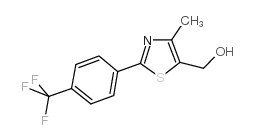
317318-96-0 |
| Literature: KALYPSYS, INC. Patent: WO2005/60958 A1, 2005 ; Location in patent: Page/Page column 115-116 ; WO 2005/060958 A1 |
|
~90% 
317318-96-0 |
| Literature: SMITHKLINE BEECHAM CORPORATION Patent: WO2004/785 A2, 2003 ; Location in patent: Page 43 ; WO 2004/000785 A2 |
|
~% 
317318-96-0 |
| Literature: EP1586573 A1, ; Page/Page column 15 ; |
|
~% 
317318-96-0 |
| Literature: WO2005/51945 A1, ; Page/Page column 88 ; WO 2005/051945 A1 |
|
~68% 
317318-96-0 |
| Literature: Pereira, Raquel; Gaudon, Claudine; Iglesias, Beatriz; Germain, Pierre; Gronemeyer, Hinrich; De Lera, Angel R. Bioorganic and Medicinal Chemistry Letters, 2006 , vol. 16, # 1 p. 49 - 54 |
|
~% 
317318-96-0 |
| Literature: Journal of Medicinal Chemistry, , vol. 50, # 4 p. 685 - 695 |
|
~% 
317318-96-0 |
| Literature: Bioorganic and Medicinal Chemistry Letters, , vol. 16, # 1 p. 49 - 54 |
|
~% 
317318-96-0 |
| Literature: Bioorganic and Medicinal Chemistry Letters, , vol. 16, # 1 p. 49 - 54 |
|
~% 
317318-96-0 |
| Literature: Bioorganic and Medicinal Chemistry Letters, , vol. 16, # 1 p. 49 - 54 |
| Precursor 10 | |
|---|---|
| DownStream 5 | |
| HS Code | 2934100090 |
|---|---|
| Summary | 2934100090 other compounds containing an unfused thiazole ring (whether or not hydrogenated) in the structure VAT:17.0% Tax rebate rate:9.0% Supervision conditions:none MFN tariff:6.5% General tariff:20.0% |

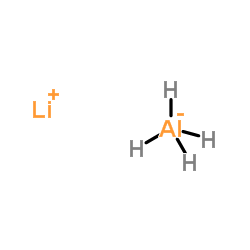


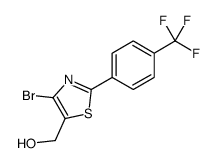
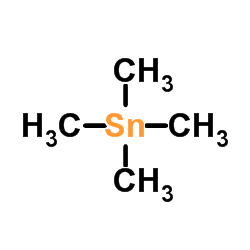
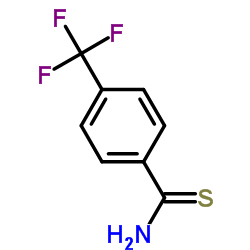
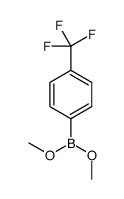
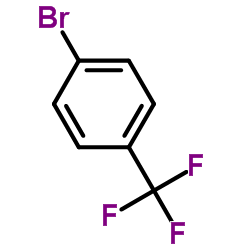
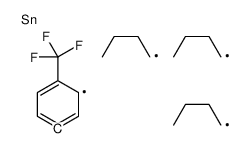
![Thiazole,5-(chloromethyl)-4-methyl-2-[4-(trifluoromethyl)phenyl] structure](https://image.chemsrc.com/caspic/458/317318-97-1.png)
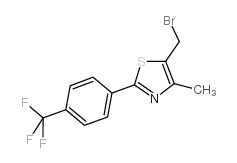
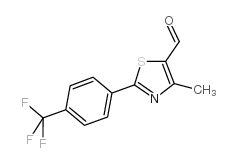
![methyl 2-[2-methyl-4-[[4-methyl-2-[4-(trifluoromethyl)phenyl]-1,3-thiazol-5-yl]methylsulfanyl]phenoxy]acetate structure](https://image.chemsrc.com/caspic/013/317318-69-7.png)
